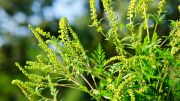
The study found that even under moderate warming conditions, pollen season in the U.S. will begin earlier and last longer, with higher average pollen concentrations in most parts of the country.
According to a Rutgers study, the distribution of allergenic pollens may change as the world continues to warm.
A team of researchers from the Rutgers Environmental and Occupational Health Sciences Institute used computer modeling to study the impact of climate change on the distribution of oak and ragweed pollens, two common allergens, in the contiguous United States.
The study, published in Frontiers in Allergy, found that by 2050, climate change is expected to significantly increase pollen levels in the air, with some of the largest increases occurring in areas where pollen is normally less common. The team was led by Panos Georgopoulos, a professor of Environmental and Occupational Health and Justice at the Rutgers School of Public Health.
“Pollen is an excellent sentinel for the impacts of climate change because shifts in variables like carbon dioxide and temperature affect the way plants behave,” said Georgopoulos, who also is director of the Computational Chemodynamics Laboratory at Rutgers and faculty at Robert Wood Johnson Medical School. “At the same time, the production of pollen and pollen’s influence on allergic disease has been increasing due to climate change, and this is one of few studies to forecast this trend into the future.”
Previous efforts to connect pollen indices with climate change have been limited by a scarcity of data. For instance, there are about 80 pollen sampling stations in the U.S., operated by a variety of private and public agencies using different sampling methods.
To overcome this challenge, the researchers adapted the Community Multiscale Air Quality modeling system, an open-source tool managed by the U.S. Environmental Protection Agency (EPA) to simulate distributions of allergenic oak and ragweed pollen for historical (2004) and future (2047) conditions.
Results showed that even under moderate warming conditions, pollen season will start earlier and last longer throughout the U.S., with increasing average pollen concentrations in most parts of the nation. Mean concentrations of oak pollen could climb by more than 40 percent in the Northeast and Southwest and mean concentrations of ragweed could jump by more than 20 percent in these areas.
Regional pollen shifts were observed, too. In parts of Nevada and northern Texas, oak pollen levels could double by mid-century, while Massachusetts and Virginia could see an 80 percent increase in ragweed pollen by 2050.
The pollen research was part of an ongoing project by the Rutgers Ozone Research Center, which is funded by the EPA and New Jersey to study how climate change will influence air quality in the state. The bulk of that work examines the state’s struggles with ground level ozone, a byproduct of fossil fuel combustion that can damage the lungs.
“New Jersey’s air quality is going to be adversely impacted by climate change, both in terms of anthropogenic pollution and increased levels of pollen,” Georgopoulos said. “For people with asthma, exposure to pollen and irritants like ozone increases the odds of respiratory illness. To protect the most vulnerable, we need to understand how these irritants will behave in a warming world.”
Reference: “Modeling past and future spatiotemporal distributions of airborne allergenic pollen across the contiguous United States” by Xiang Ren, Ting Cai, Zhongyuan Mi, Leonard Bielory, Christopher G. Nolte and Panos G. Georgopoulos, 25 October 2022, Frontiers in Allergy.
DOI: 10.3389/falgy.2022.959594
The study was funded by the National Institute of Environmental Health Sciences, the National Institutes of Health, the Environmental Protection Agency, and the New Jersey Department of Environmental Protection.









“A team of researchers … used computer modeling …”
How were the models and the outputs validated?
“…, the distribution of allergenic pollens MAY change …”
The operative word here is “may.” Mathematics has been called the language of science. Where are the numbers in this article? Specifically, what is the numeric probability, and the associated uncertainty, for a given change? How large of a change is expected, and what is the uncertainty associated with the nominal change?
When plants, such as oak, produce their Spring pollen, it seems reasonable that they may do so earlier with the last killing frosts not coming as late. However, where is the evidence, or at least a reasonable explanation, for why the flowering should last longer?
In my short 62 years of life on Earth, I have seen Spring tree leaves open for the same location as early as February during the 1990s and early 2000s and as late as May in recent years. My reading of private journals from people living in the 1800s and early 1900s shows that temperatures have fluctuated yearly throughout the past 100+ years. My reading of paleoclimate data has revealed that the climate has been changing both rapidly and slowly and at different rates for different locations for the past 100,000 years. Is there a possibility that rapid and slow climate change on Earth is regular and cyclical regardless of the perceived cause? Isn’t that how the variability of tree ring growth is interpreted?